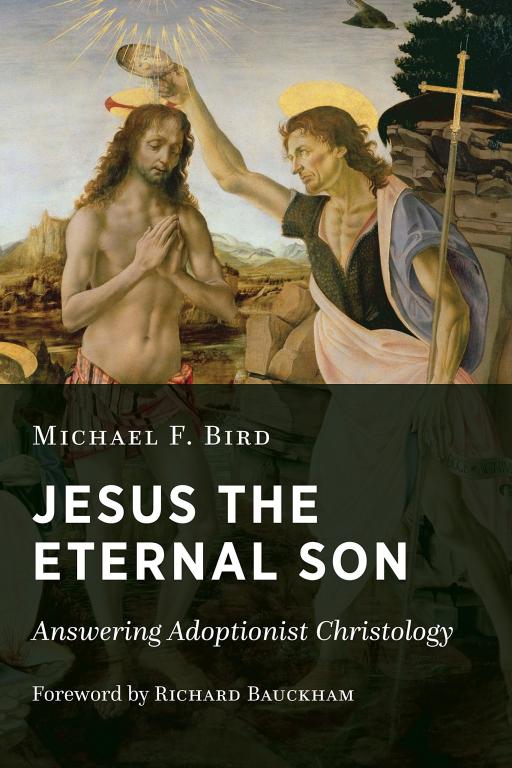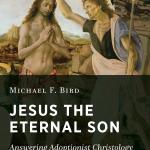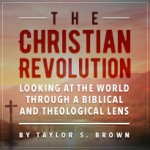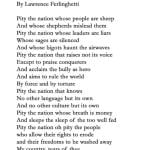
Well, we have arrived at the end of Michael Bird’s excursion through the various adoptionist readings of several key New Testament texts in his Jesus the Eternal Son: Answering Adoptionist Christology. With the last two chapters of the book Bird seeks to answer the questions of (1) roughly when adoptionist Christologies actually arose and (2) why adoptionism has experienced a resurgence of popularity in certain academic circles in the last century.
The title of chapter five, “How Jesus Got Adopted in the Second Century,” gives a good preview of Bird’s argument therein. Of course the second century is a broad timeline; one hundred years to be exact. Thankfully for the reader, Bird narrows the list of possible suspects for the promulgation of a full-fledged adoptionist Christology down to three: the Shephard of Hermas, the Ebionites, and the Theodotians (p. 107). Each of these has, in some way, been pegged by scholars over the last several decades as potentially (and even likely) having distinct elements of full-fledged adoptionist Christological tendencies. But what happens when we actually analyze them in-depth? That is the question that Bird asks.
Bird first looks at the Shepherd of Hermas, a popular early Christian writing dating to around the mid-second century A.D., likely with origins in Rome (p. 107) Indeed, many early debates about the canon of Holy Scripture involved the question of whether or not the writing should be included within the canon of the New Testament. However, the majority of early Christian thinkers on the Scriptural canon rejected Hermas on the basis of its lack of both apostolic authorship (in contrast to books like the Gospel of John or the Pauline letters) and authorship by someone who used apostolic eyewitness testimony (in contrast to works like Luke-Acts and the Gospel of Mark, who likely used Peter’s memoirs in the writing of his gospel). But all of this is beside the point of Bird’s analysis.
Regardless of the history of canonical debates, several scholars have argued that Hermas has some of the earliest clear-cut adoptionist Christology in the form of its fifth parable, which deals with a landlord, the landlord’s son, and a faithful servant who is made a fellow heir alongside the son for his good work. These three are typically viewed as parabolic proxies for the Father, the Holy Spirit, and Jesus, respectively. While space does not permit an exhaustive summaryof Bird’s analysis (because you should just read his analysis itself) suffice it to say that he argues against this for four main reasons. First, elsewhere in Hermas there is a very clear attribution of the pre-existence of Christ before all creation. Second, the main purpose of the fifth parable in Hermas is to express that good works are superior to fasting. The purpose of the parable is to discuss issues surrounding salvation, not Christology, Third, the servant in the parable is not adopted as a son of the master, but simply as an heir. This does not necessarily imply adoption into full sonship. Finally, the reception of power and lordship (part of the parabolic nature of the story in referring to Christ) is no more adoptionist than the risen Jesus in Matthew’s Gospel (which is very much not an adoptionist text) receiving these same attributes (Matt 28:18) (p. 111). The upshot of all of this is that the Christology of the Shepherd of Hermas, while confused, confusing, and not exactly what one would call proto-Nicene, is not adoptionist.
After dealing with Hermas, Bird moves on to a discussion of the supposed adoptionist Christology of the Ebionites. The Ebionites were an early Jewish Christian group that we really know very little about. What little is known about the group is quite contested in its historical veracity and comes almost entirely from their Gentile Christian opponents. This already, of course, puts historians on shaky ground in regards to discerning the Christology of the Ebionites. (p. 112-13). Add on to this already uncertain state of historical affairs the fact that there seems to have been several differing varieties of Ebionism, with no one monolithic (or even really generally centralized) form of Ebionite Christology (pp. 115-16). This problem of sources, combined with several other factors (not least that adoptionism seems to have originated in culturally Romanized territories, with thoughts of imperial adoption, rather than in far more Jewish and Hellenized territories like Palestine or Syria) leads Bird to conclude that, while the Ebionites almost certainly had a non-proto-Nicene form of Christology (possibly a form of “possession” Christology wherein a heavenly power entered into the Jewish man Jesus), it was most likely not adoptionist in nature (pp. 117-20).
This brings us to the most likely culprit for the promulgation of the first, full-fledged adoptionist Christology: the Theodotians. The sect was named after Theodotus of Byzantium, a leather worker who came to Rome in the late second century and who, while adhering to orthodox beliefs surrounding such things as creation and even the virgin birth, nevertheless said that Jesus was simply a “mere man” (albeit a supremely virtuous one) upon whom the Holy Spirit descended at his baptism, allowing him to perform miracles (p. 120). Theodotus was, rightly, excommunicated after refusing to recant from his heretical claims. While Theodotus himself cannot properly be called an adoptionist (he claimed that Jesus was a mere man upon whom the Spirit descended, not that Jesus’s ontological status changed), pockets of his followers began to spring up around Rome putting forward various iterations on his underlying claims. One of these groups (most likely in the late 190s/early 200s and probably influenced by the deification of several Roman emperors at the time) soon modified Theodotus’s claims by saying that the man Jesus was deified after his resurrection. It is here, through a group of Theodotians in the late second-century in Rome, Bird argues, that adoptionism properly understood first took form (pp. 121-22).
So why then the modern fascination with adoptionist Christology among modern New Testament scholars and historians? If the line of evidence for the origins of adoptionism can reasonably be traced back to the Theodotians in second-century Rome, and not to the actual NT writers, why have a number of prominent scholars (many of whom like James D. G. Dunn are otherwise orthodox in their Christian convictions) argued for adoptionism as the earliest form of Christology? While I am sure that such scholars truly believe that the evidence points to adoptionism, it seems that a deeper, fully contextual analysis of the NT documents (particularly the Mark’s Gospel) points far more toward a proto-Nicene form of Christology. The question is then, what factors are at play that seem to have made adoptionism so popular in scholarly circles as of late? Of course one factor is a historical zeitgeist that originated with German liberal Protestantism in the schools of thought founded by thinkers like Schleiermacher, von Harnack, and Bultmann. As the modern historical-critical study of the New Testament arose in the nineteenth and twentieth centuries, it did so alongside of rationalist and liberal Protestantism in largely German academic circles. Thus, many of the erroneous theological and philosophical assumptions of that period and movement became bound up with its scholarship. Assumptions such as the impossibility of incarnation or of the supernatural entering in general meant that Jesus couldn’t have been God the Son incarnate, because as all good German form critics know, God can’t actually act in the world that way. Please note the sarcasm in that last sentence (pp. 125-27).
Of course there are other reasons that modern thinkers hold to adoptionism. Humans are complex creatures and hold beliefs for a variety of different reasons. It would thus be wrong to boil all modern adoptionists down to just a modern form of liberal or pseudo-liberal Protestants. Nevertheless, I (and Michael Bird of course) disagree with their conclusions vis-a-vis adoptionism. While there are multiple reasons to disagree with adoptionism (not least the exegetical and historical reasons that Bird has devoted the bulk of his book to discussing) Bird lists two major ones related to the economy of salvation. First, modern adoptionists (just like ancient ones) run into the problem that Athanasius discussed so thoroughly in his masterwork, On the Incarnation, namely that one created being (even the most virtuous one) cannot redeem another created being. The logic here is that the only power strong enough to defeat Death and Sin is the very Ground and Source of Life, Love, and Goodness Himself. Death, decay, and corruption are near-omnipotent forces in the fallen, shattered world we inhabit. They are near-omnipotent, but not fully so. Thus it is only God, the inexhaustible source of existence and life who is Himself beyond all created and finite things, who can take on the weight of Death itself and exhaust it, so that His creatures might not taste its sting. A Jesus who was merely deified may seem at first glance to be more relatable to us, but ultimately he is no true redeemer. The second major problem with adoptionist Christology is that it turns salvation into a wholly meritorious process. While good and ethical behavior is intrinsic to the Christian life (indeed, they are concomitant with what it means to be redeemed), to make them the sole basis of salvation as adoptionism implies is to foster a modern form of “pull yourself up by your bootstraps” mythology. Bird quotes Justo Gonzalez to sum up the theological problems with adoptionism:
Jesus Christ must be more than the first among the redeemed, more than the local boy who makes good. He must also be the Redeemer, the power from outside who breaks into our closed reality and breaks its structures of oppression. He must be more than the “adopted son of God.” He must be God adopting us as sons and daughters.
– Justo Gonzalez, Manana: Christian Theology from a Hispanic Perspective (Nashville, Abingdon, 1990), 144-45
Well, there you have it readers. We have worked our way through Michael Bird’s book, Jesus the Eternal Son: Answering Adoptionist Christology! Of course it went far slower than I anticipated, but such is the struggle of blogging through a book while also working a day job, eating, sleeping, and binge watching Netflix. Nevertheless, I enjoyed the ride and I hope the handful of you who have read these posts did as well. Now go out, pick up a copy of the book for yourself, and give it a read!
Soli Deo Honor et Gloria












